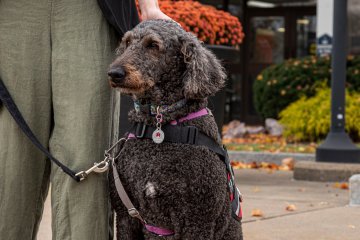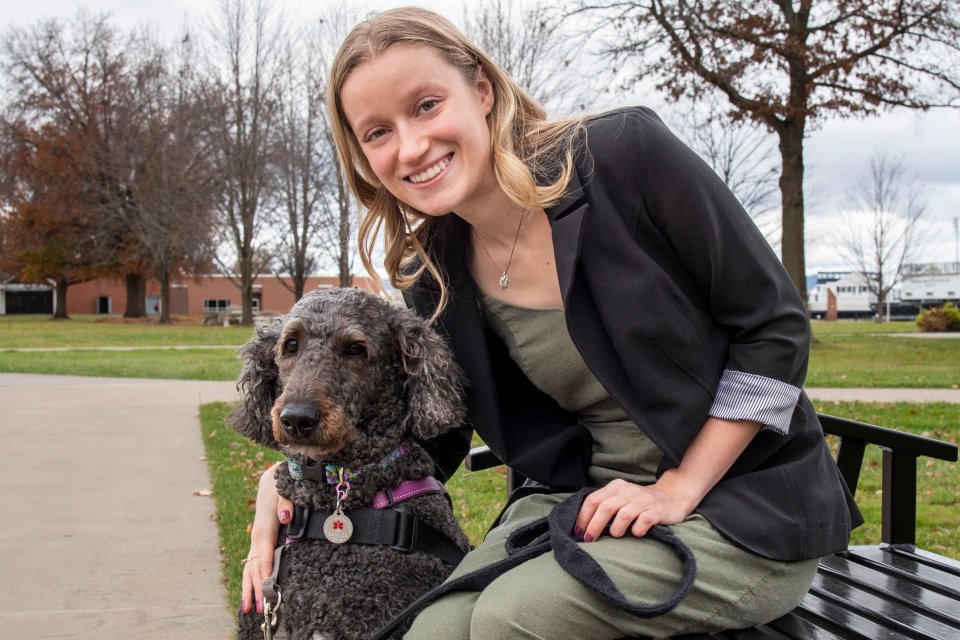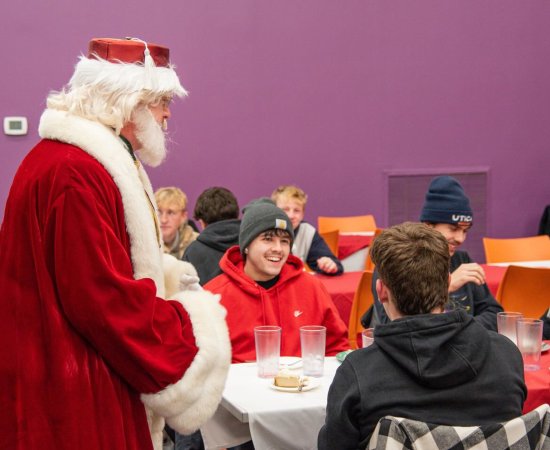
Survivor. Advocate. Inspiration. Anna Owens G’24

“I want to inspire my patients to recognize that every day is worth living, every moment is worth cherishing, and every challenge is worth facing.”
The lullaby of the hospital monitors. Years of unanswered questions. Perhaps after all this time wondering what was wrong, she might have felt a sense of relief in that hospital bed that someone had finally discovered the source of her pain.
But at that point, Anna Owens G’24 already knew she was dying.
At the age of 14, she had already been incredibly sick for two years. Her symptoms began in 2012 when she was laying on her trampoline with the family dog. The ten to fifteen-pound Yorkie-Poo walked by her head and Anna immediately became dizzy. With the world spinning around her, she threw up – the first of many such instances over the next few years as she made her way through middle school.
“I would have nausea almost every morning between ten and eleven. I remembered a class I’d always get sick in. I’d vomit and would stop moving my neck because when I did, I’d always get dizzy. I didn’t know at that age that what I was doing was overcompensating.”
Misdiagnosed time and time again, she would always come away from her medical visits with even more questions. It wasn’t until she began experiencing intermittent blindness that she started getting some answers. Her optometrist discovered a lesion behind her eyes and sent her to a retina specialist who ordered an MRI. By the end of the week, she was being admitted to Golisano Children’s Hospital.
One might think that there would be relief in finally getting some answers, but she was in no shape to feel much of anything.
“I could feel that I was dying,” she says. “And when I arrived at Golisano, I was so relieved when they told me it was a brain tumor because someone had finally told me what was wrong. I knew this was my only hope or I was going to die. Once you get to that point, I felt like I didn’t have time to react. Someone didn’t have to tell me there was a possibility I could die because I already knew it was happening.”
Entering an unimaginable world
The doctors told Anna that she was dealing with hydrocephalus. Due to where the tumor was located, cerebral spinal fluid was being blocked from the rest of her body, and that fluid was building up.
“The minute I got there, they inserted a shunt in my head and then performed brain surgery the next morning.”
Her mother never left her side during that time Anna calls “an unimaginable world in the mind of an innocent.” Her hair was unkempt and covered in her own blood and snarls, her forehead bearing two symmetrical scabs that marked where they had screwed her head into the table. But what Anna says her eyes were so drawn to in those moments was the shunt, which she often referred to as “the tube.”
“That tube was my best friend, yet I wanted so badly to get rid of it and it wouldn’t let go of my hand,” she says. “The tube slithered into the top of my head and sucked out the enormous amount of venom that had been stored there over the course of two years.”
Even now, years later, feeling a completely new person than the young girl sitting in the hospital, she feels like that tube would always be there in her head.
“That tube and that entire moment inspired me to survive. Not just physically survive, but to survive spiritually, mentally, and emotionally. I am a survivor and as a survivor I am strong, determined, grateful for today, and genuinely full of love.”
Her healthcare team referred to her as “the miracle case,” a term she is humble enough to admit could be true for many individuals, depending on their beliefs. But Anna is also confident enough in the power of her determination to know that it enabled her to overcome obstacles that others, even her healthcare providers, saw as insurmountable.
“If I close my eyes after all these years, I can still hear the lullaby of the monitors that sang to me every night. I could see a child no older than eight years old walking past my doorway in the same armor as myself. I’ll never understand how young children can be the targets of such severe illnesses. I hate seeing anyone, especially the pure, suffer to the point where they can’t live happily anymore,” she says.
Working her way back
A week later, she was homebound, going to physical therapy three times a week and trying to keep herself occupied during recovery.
“I like to keep busy, so during recovery I did a lot of journaling, coloring, and listened to a lot of music,” she recalls. “I got back into playing piano. I did a lot of cooking. My family joked they all gained weight because of all the cooking I was doing. I was also frustrated because I felt so great when I got home but the pressure in my brain was still healing, still going down. So I couldn’t go out and go for a run for a long time. I couldn’t do much that was physical even though I wanted to, outside of physical therapy.”
While Anna worked to keep herself from going stir crazy, she continued her recovery with both physical therapists as well as her private coach, Kevin Green, who helped make sure the one-time softball player was working her way back to the game.
“I was very close to him. He was also part of my healthcare team, in my opinion. His one-on-one with me to get me back into shape and to playing softball was invaluable. He took the time to adapt with me too and determine how I could return safely to the sport,” Anna says.
Other than her ongoing physical therapy, much of her recovery was spent at home, which meant sitting out the remainder of her 8th grade year. A review of her work by the school determined that, despite all she had missed due to her medical absence, she would be able to segue into 9th grade in the fall.
“I was lucky,” she says. “I had a lot of friends and I loved school and I was so excited to go back. Kids are good at adapting to change and I was ready to go back. It ended up feeling like an ordinary school year.”
Though the return to school was not without its difficulties. She may have been out of the hospital and out of recovery, but she still wasn’t a hundred percent, and had frequent appointments or days when she would not be physically capable of completing a full school day.
“I didn’t realize until I got older that a lot of stuff wasn’t there to help me and I had to be my own advocate. I missed a lot of school due to needing half days or sick days. I had to work with my teachers and figure out how to balance things and make up work because of either needing to be out for therapy or just being sick. It made me wish there was an occupational therapist there who could have advocated for me and worked with the teachers. I had to do that myself as a teenager and advocate for myself,” Anna says.
It’s an issue she says she thankfully didn’t have once she came to Utica University.
She longs for such a position to be in place for students like herself in high school.
“I just wish someone had been there,” she says, recounting how even during the years she was sick, medical professionals had brushed off what she was dealing with because she was still able to act normal and do sports. The years of disregard forced her into advocating for herself.
“In high school, I was doing okay, but I was far too young to be balancing all those responsibilities and being my own advocate. As I’ve gotten older and learned more about resources out there, I realized how much I was doing for myself.”
Becoming a therapist
Despite the challenges she faced, she made it through, eventually landing at SUNY Polytechnic Institute as a biology major with plans to become a neurosurgeon.
“I wanted to be a doctor, but as I started going through their program, I started thinking about the type of care I always wanted to give my clients,” she says. “I felt the more I learned what I’d be doing as an MD, I thought it might not be what I wanted after all. The people that I have looked up to and wanted to be like have been my therapists. Once that clicked in my head, I knew about the occupational therapy program at Utica and transferred here for my junior year.”
And what a time to leap into Utica – in the summer of 2020, the world still in the grip of the COVID-19 pandemic and months prior to the development of COVID vaccines, forcing many institutions like Utica to move classes online.
“We did all our labs at home because of COVID. We couldn’t go into the lab and everyone was trying to figure out what to do. Materials were sent to the student, including a goat brain, and labs were done from home. It was just really gross. Something I never want to do again. The teachers were great, though.”
She joined other students back on campus that fall and as she immersed herself more and more in the world of occupational therapy as a student, she started gaining further understanding of her own medical issues as a patient.
“I had only seen one side of it when I was a patient, going through Occupational Therapy at Faxton Hospital with Amanda Wallace, who did myofacial release therapy with me on-and-off as needed for my neck. We’d do exercises and emulate things like me doing laundry, which I couldn’t do on my own at one point. It didn’t have to do with strength, so it didn’t fall into the category of physical therapy, and thus occupational therapy was where I found what I needed. I needed someone to help me adapt to the situation. The therapy she did to my neck really broke up some of the adhesions I had going on and it enhanced my ability to move,” Anna says.
Once she did start moving her neck, she says her body was so unaccustomed to it that she’d feel incredibly sick.
“You don’t think about little things like that until you do them and that’s what I love about occupational therapy and why I chose it,” she says. “It’s not always about strength and endurance. My physical therapists were superstars as well, but occupational therapy is very holistic and focuses on how you can get there. Sometimes you have to be creative. It’s not as simple as exercise. Now, when I work with my clients, I just feel like I can see myself on the other side. It makes my practice better, more client-centered, and not just a job. I know they’re a person.”
She says she found her time at Utica to be empowering and never had the struggle for accommodations that she had to advocate so strongly for back in high school.
“At Utica, getting accommodations was really easy. I’d just go to Judy Borner, the Director of Learning Services, and she took care of everything. She’s been great. It’s been so simple since I’ve been here,” says Anna.
“The thing that makes the program so great here is the faculty. When I got here, I could see why. The faculty really embodied what the occupational therapy profession is all about, assuring me from the very start that I had a place in the profession. They didn’t see me as a difficult case to work with. They adapted with me, they empowered me, and they supported me in every way.”
Practicing with Penny

At the end of her junior year at Utica, Anna began getting the hands-on experience Utica University is known for, putting her wealth of experiences both in and out of the classroom to work with patients in real-world settings like the Rescue Mission of Utica and Mount Markham Elementary School. She spent 12 weeks at each site, providing occupational therapy with the help of her service dog, Penny. Anna has been working with Penny, now five years old, since her freshman year of college.
“She’s an extension of myself,” she says.
Unsure at first how she’d incorporate Penny into her Practice, Anna says her professors in the occupational therapy program at Utica helped her develop a
plan for Penny to work alongside her. Now, the two are inseparable, going everywhere from classes to doctor appointments to the grocery store.
“And some people are incredibly supportive. Others are not. I’ve gotten harassed out in the community by people who don’t understand and give you a hard time about having a dog, even when she’s wearing her vest. Part of that, I think, is being a young woman. I don’t know if I’d get that as an older male.”
The Rescue Mission is what Anna describes as a “non-traditional site,” meaning that there was no occupational therapist there when she began. She and one other student worked with Assistant Professor of Occupational Therapy Cicily Talerico to try to establish an occupational therapy program there full-time.
“Penny’s presence there really gave people a reason to smile. I didn’t realize just how therapeutic she could be until I was out doing fieldwork with her. She stopped a client from having a panic attack. Penny walked right over to the client as it was taking hold and put her face tight into the client’s lap. And the panic attack stopped.”
The experience led Anna to her first peer-reviewed publication by the American Occupational Therapy Association “Witnessing the Power of Occupation Working With the Unhoused.”
Her experiences at Mount Markham Elementary School, while very different, were just as rewarding. With an occupational therapist already on site at the school, Anna worked with children across a range of diagnoses.
“I loved the kids there. It was very hard for me to leave. I always envisioned working in pediatrics due to my own experiences. I know what it’s like to be a sick kid and struggle like that,” she says.
As she prepared to walk across the stage in May 2024 completing the occupational therapy bachelor’s to master’s program, with Penny at her side, Anna looked back on what she calls “an intense program” and the thing that got her through it the most – the Utica University faculty.
“I don’t know how I would have gotten through the program without them. I really feel blessed that I came to this program and had these professors. They just really empowered me and got me through. They made me feel like I could do it.”
Being the hero to others
While her journey to recovery inspired her path to becoming an occupational therapist, it has also driven her to devote her time to the Pediatric Brain Tumor Foundation (PBTF) as an active volunteer and fundraiser, along with participation in their events such as the Starry Night Walk in Boston and the Ride for Kids right here in Utica.
Through these events, Anna works with fellow brain tumor survivors to raise awareness and funds for continuing research.
Post-graduation, she plans on doing research with Assistant Professor of occupational therapy Yvonne Monti on the impact of occupational therapy combined with service dog intervention on sleep dysfunction. She says she’d love to work with kids again, or explore more of occupational therapy’s role in mental health.
“I want to inspire my patients to recognize that every day is worth living, every moment is worth cherishing, and every challenge is worth facing.”
Whatever the future holds, Anna is ready to take it on with passion and looks forward to the journey.
“I’m grateful I chose a career where I have a lot of opportunities,” she says. “I love this profession even more than when I started the program. It fit my personal healing journey that I started when I was 14. I’d like to be the hero that I wish I had, but to other people.”
More Stories

Dr. Rutal Mahajan Earns NVIDIA Generative AI Certification
Rutal Mahajan, assistant professor of computer science, earned Nvidia Generative Artificial Intelligence (AI) Large Language Models (LLMs) Certification at Nvidia’s...

Students, faculty, and staff ring in the season with annual Holiday Dinner
The holiday season is here once again and before the semester draws to a close, the campus came together to...

Utica University Chosen as a Regional Site for Mock Trial National Championship Tournament
The American Mock Trial Association has selected Utica University as a National Championship Tournament regional host site. The AMTA hosts...
I would like to see logins and resources for:
For a general list of frequently used logins, you can also visit our logins page.
